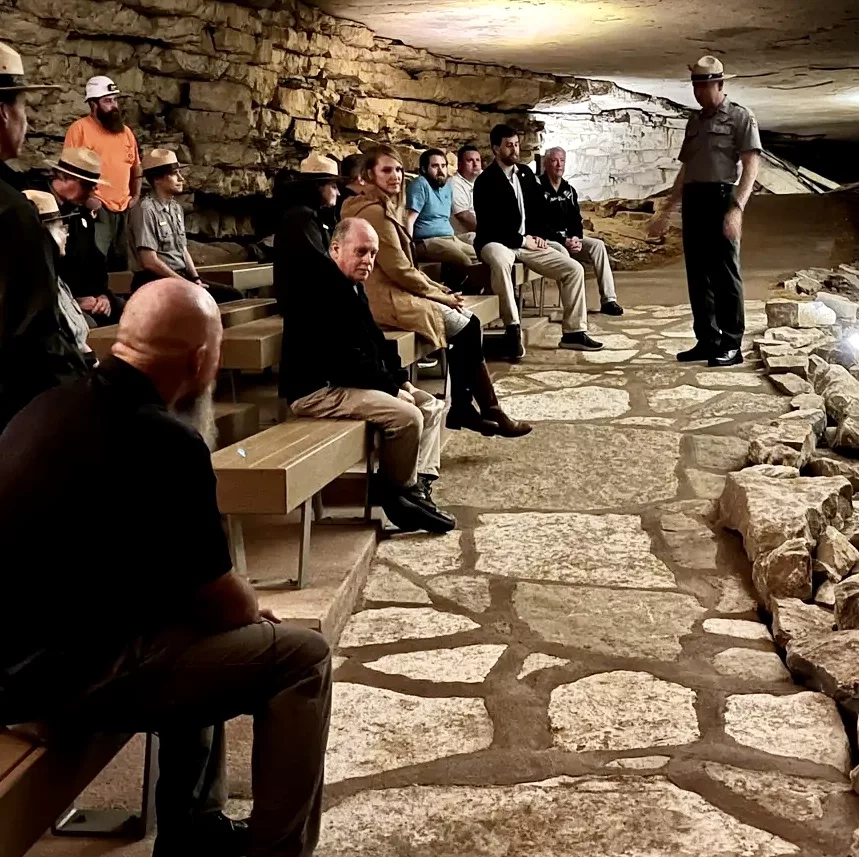In the depths of Mammoth Cave, where centuries of history lie hidden beneath layers of earth and asphalt, a team of trail construction crews stumbled upon a remarkable discovery. Buried beneath a century of dirt, they unearthed remnants of a flat stone walkway dating back to the 1920s, shedding light on a forgotten chapter of the cave’s history.
Mammoth Cave Public Information Officer. Molly Schroer spoke to WCLU about the discovery and the construction leading up to it.
The historic find, located in the Fairy Ceiling area of a 1-mile section of cave trail, revealed traces of a Morrison Era Trail, a pathway constructed by cave entrepreneur George Morrison.
Schroer, elaborated more on Morrison’s business practices and capitalistic ventures.

Morrison’s arrival in South Central Kentucky in 1915 was initially driven by the quest for oil, yet his legacy would be intertwined with the history of Mammoth Cave in ways he never anticipated. Morrison’s aspirations for oil exploration quickly shifted as he became fascinated by the underground wonders of Mammoth Cave and the lucrative potential of cave tourism.
Despite initial setbacks, including being caught trespassing in the cave, Morrison’s determination remained unyielding.
Unable to access Mammoth Cave through conventional means, Morrison forged unconventional paths, forming alliances with local landowners.
His persistence paid off when he obtained permission to blast into a sinkhole on Perry Cox’s land, revealing connections to the historic section of Mammoth Cave.
Undeterred by setbacks, Morrison returned in 1921 with a new strategy, purchasing land and uncovering cave passages that he could claim as his own. By 1922, he opened his cave to the public, branding it as the New Entrance to Mammoth Cave.
Morrison’s fortunes soared with the discovery of the Frozen Niagara formation in 1923, cementing his dominance in the local tourism industry. However, tragedy struck with the entrapment of Floyd Collins in Sand Cave in 1925, prompting efforts to establish Mammoth Cave as a national park. Despite his success, Morrison’s tenure was brief. In 1932, he sold his portion of Mammoth Cave, marking the end of an era.
Tragically, Morrison’s life ended in 1937, long before Mammoth Cave gained national park status in 1941.
Upon the discovery of the Morrison Era Trail, new trail construction efforts came to a halt as the Mammoth Cave Cultural Resource Management Team was called in to assess the significance of the find and devise a strategy for its preservation.
Collaborating closely with the trail contractor, the team explored various options and ultimately decided that the best course of action was to integrate the historic pathway into the design of the new trail.
Today, visitors to Mammoth Cave have the opportunity to witness this piece of history firsthand, as the preserved Morrison Era Trail is featured on several cave tours, including the popular Domes and Dripstones and Grand Avenue tours. This restored section of the cave’s infrastructure serves as a tangible link to the early 20th-century tourism boom that shaped Mammoth Cave into the iconic travel destination it is today.
As cave guides lead visitors along the footsteps of those who contributed to the development of this natural wonder, they offer a glimpse into the rich tapestry of history that lies beneath the surface of Mammoth Cave.
“…And what can equal in wonder and surprise the marvelous halls; the beautiful avenues; magnificent chambers; lofty domes and wonderful grottos, overhung with dazzling splendor, and all shrouded in eternal gloom?” – George Morrison, on the New Entrance of Mammoth Cave.





